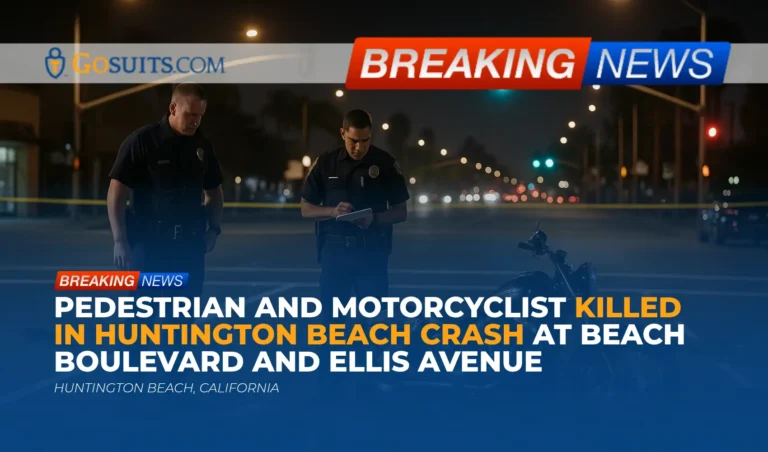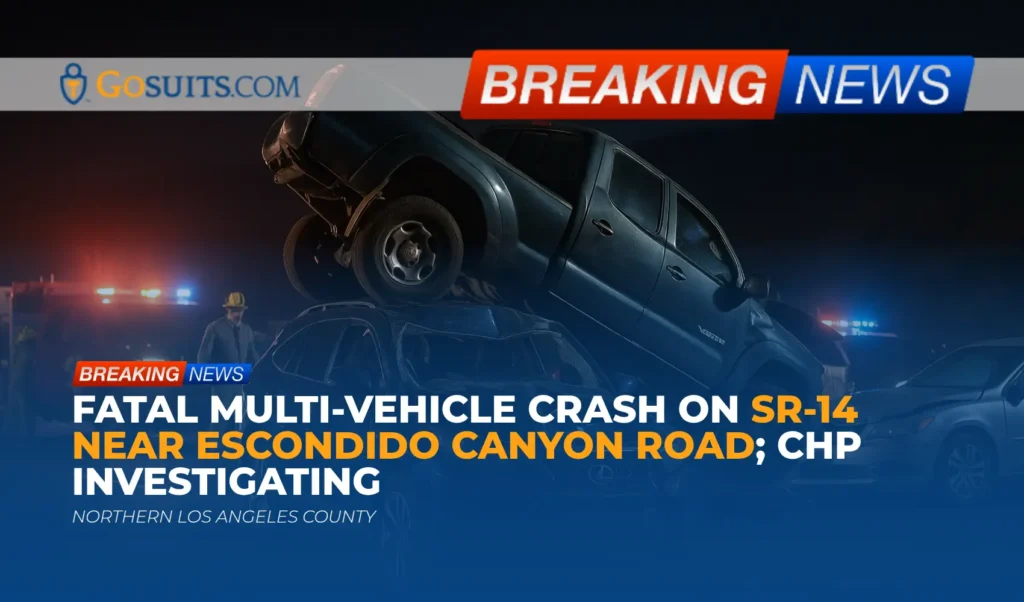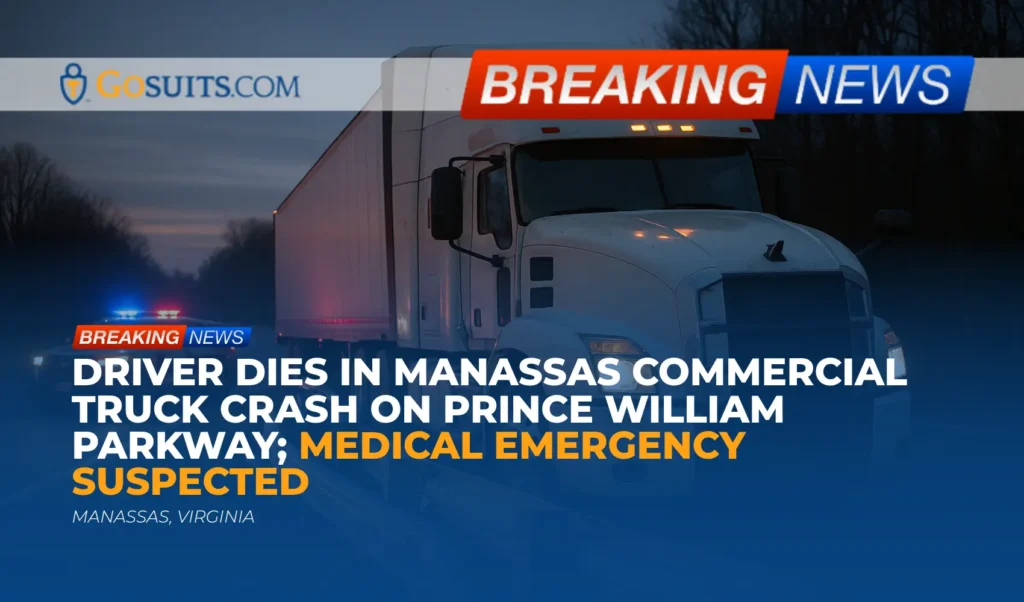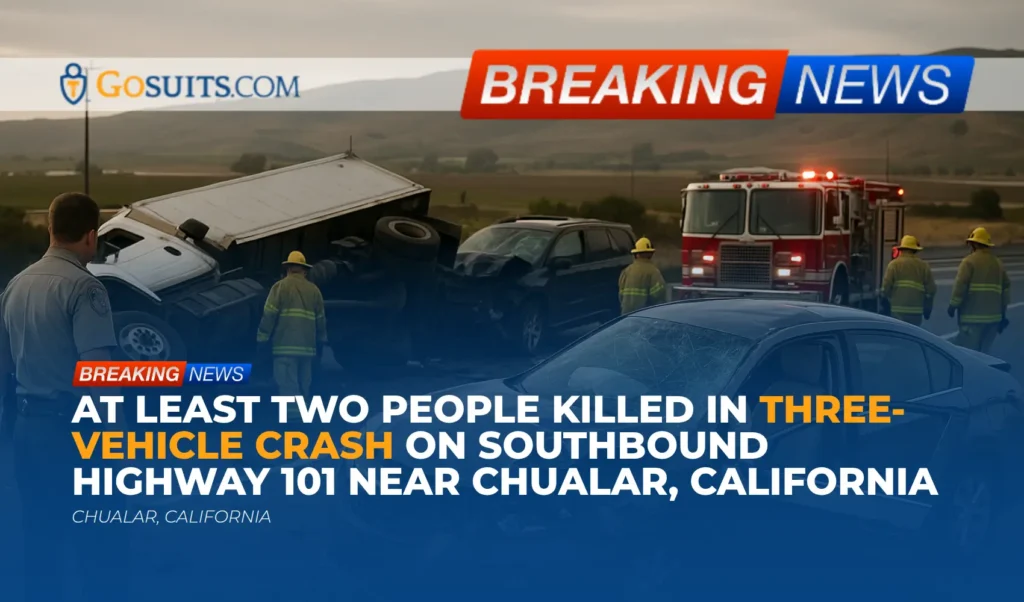- What Happened at Beach Boulevard and Ellis Avenue in Huntington Beach
- Law Enforcement Status and How Investigations Typically Proceed
- California Law: Duties of Drivers and Pedestrians at and between Intersections
- Potential Civil Claims and Liability Pathways
- Insurance Considerations After a Pedestrian–Motorcycle Fatal Collision
- Critical Evidence to Preserve Right Away
- Where Families Can Request Official Records and Get Help
- Safety Context: What National and State Data Tell Us
- What to Do Before Speaking With Any Insurance Company
- Commentary from Gosuits Huntington Beach, California Personal Injury Attorney
- Why Timely Action Matters
- Sources and References
What Happened at Beach Boulevard and Ellis Avenue in Huntington Beach
Authorities reported a tragic collision in Huntington Beach that resulted in the deaths of two people: a pedestrian and a motorcyclist riding a black Harley-Davidson. The incident occurred at approximately 8:27 p.m. at the intersection of Beach Boulevard and Ellis Avenue. According to preliminary information shared by officials, the Harley-Davidson was traveling southbound on Beach Boulevard when it struck a pedestrian who was crossing the roadway outside of a crosswalk.
Responding officers found both individuals unconscious in the roadway. The motorcyclist, identified as a 45-year-old man from Los Angeles, and the pedestrian, identified as a 46-year-old Huntington Beach resident, were both pronounced deceased at the scene by paramedics. At this time, investigators have not indicated whether alcohol or drugs played a role. The Huntington Beach Police Department’s Multidisciplinary Accident Investigation Team is handling the investigation, and witnesses were asked to contact the assigned traffic investigator.
This article shares publicly available details at the time of writing, offers context about how such investigations typically unfold, and outlines information families often need in the days and weeks after a fatal traffic collision. We extend our deepest condolences to those affected.
Law Enforcement Status and How Investigations Typically Proceed
When a fatal collision occurs, the local police agency often secures the scene, documents physical evidence, maps the roadway, measures skid or yaw marks (if any), and interviews witnesses. Photographs, vehicle inspections, and reviews of traffic signal timing logs or nearby surveillance video are commonly part of the reconstruction process. In Huntington Beach, the Multidisciplinary Accident Investigation Team conducts these tasks with a focus on understanding speed, line of sight, lighting conditions, lane positioning, roadway design, and the actions of all parties in the seconds before impact.
While preliminary statements can offer early clues, the final collision report and any supplemental forensic analyses usually take longer to complete. Families should be aware that additional evidence sometimes emerges later, such as traffic camera footage, 911 recordings, or third-party surveillance video from nearby businesses or residences. This material can be important in civil claims, especially when responsibility is contested or when more than one factor contributed to the crash.
California Law: Duties of Drivers and Pedestrians at and between Intersections
California law assigns duties of care to everyone using the road. Even when a pedestrian crosses outside a crosswalk, drivers still must exercise due care to avoid a collision, and pedestrians must yield to vehicles when crossing outside marked or unmarked crosswalks. Understanding how these duties interact is essential for families trying to make sense of what happened.
Drivers’ duty of care and the basic speed law
Under California’s basic speed law, drivers must never travel faster than is reasonable or prudent for conditions, considering visibility, traffic, and roadway features, even if they are below the posted limit. This principle appears in the California Vehicle Code and emphasizes that speed should match real-world conditions, such as darkness, glare, or heavy pedestrian activity. See Vehicle Code section 22350.
Pedestrian right of way and crossing outside crosswalks
California law requires drivers to yield the right-of-way to pedestrians within any marked crosswalk or within an unmarked crosswalk at an intersection, and to exercise due care for pedestrian safety. See Vehicle Code section 21950.
When a pedestrian crosses outside a crosswalk, they must yield to vehicles on the roadway, but the law still preserves a driver’s duty to use due care for the pedestrian’s safety. See Vehicle Code section 21954. In other words, crossing outside a crosswalk does not erase a driver’s obligation to be careful; it simply adds a duty for the pedestrian to yield when outside a crosswalk.
Taken together, these provisions recognize that real streets are shared spaces where conditions change. At-night lighting, vehicle speeds, and sight lines all matter. Investigators typically evaluate whether road users acted reasonably, given those conditions.
Potential Civil Claims and Liability Pathways
In a two-fatality collision like this, families often face difficult questions about responsibility and what civil claims may be available. California uses a comparative fault framework, which means responsibility can be shared between parties in proportions that reflect each person’s contribution to the crash. This does not prevent a claim; rather, a claimant’s compensation can be adjusted by their percentage of fault. The California courts recognize comparative fault in civil cases, and California’s jury instructions address how jurors consider comparative responsibility. See the Judicial Council’s resources for civil jury instructions on the courts’ website, which discuss comparative fault principles in general terms.
Wrongful death and survival actions
Following a fatal crash, two broad categories of civil claims may be considered:
- Wrongful death claims by certain surviving family members for losses such as the value of the decedent’s financial support and the loss of companionship, among other damages. See Code of Civil Procedure section 377.60. The general statute of limitations for a wrongful death lawsuit in California is two years from the date of death. See Code of Civil Procedure section 335.1.
- Survival actions on behalf of the decedent’s estate for certain damages the decedent could have pursued had they lived, such as property damage or pre-death medical expenses, where recoverable. See Code of Civil Procedure section 377.30.
Which claims apply, and how they are pursued, depends on the facts and on who is legally entitled to bring them. Importantly, families should know that different deadlines and notice requirements can apply depending on who the potential defendants are.
Comparative fault in pedestrian–vehicle collisions
California’s comparative fault allows a judge or jury to assign percentages of responsibility among multiple actors. In practical terms, a pedestrian who crossed outside a crosswalk might be assigned some portion of fault; however, investigators and courts still evaluate whether a driver was traveling at a safe speed, scanning ahead, using headlights properly, or could have avoided the collision with reasonable care. Because each case is fact-specific, collision reconstruction findings and objective evidence can weigh heavily.
Public entity liability for dangerous roadway conditions
If aspects of the roadway environment contributed to the collision, such as inadequate sight distance, malfunctioning signals, or other hazardous conditions, claims against a public entity may be explored under California’s Government Claims Act. Liability for a dangerous condition of public property is addressed in Government Code section 835.
Notice requirements for claims against public entities are strict and short. In many cases, a written claim must be filed with the public entity within six months of the incident. See Government Code section 911.2. This is a separate requirement from a lawsuit in court. If a public entity might be involved, prompt action to investigate and preserve rights is essential.
Insurance Considerations After a Pedestrian–Motorcycle Fatal Collision
Insurance issues after a fatal crash are often complex, especially where both parties suffered fatal injuries. Several insurance policies may be relevant, and each has different rules, exclusions, and time limits. While every policy is different, these general points can help frame the discussion:
- Motorcycle liability insurance. If a motorcyclist is found to be at fault, their bodily injury liability coverage can respond to claims brought by a pedestrian’s family. If fault is disputed or shared, insurers may still investigate and negotiate based on evidence and comparative fault principles.
- Uninsured/Underinsured Motorist (UM/UIM). When a third-party driver is involved and lacks adequate coverage, injured parties or families sometimes turn to UM/UIM on their own policy. In a two-party collision like this, UM/UIM may not apply unless a separate at-fault driver is identified who is uninsured or underinsured. Policy language controls. The California Department of Insurance provides consumer information about auto coverages at insurance.ca.gov.
- Medical Payments (MedPay). Some policies include optional MedPay that can help with certain medical or funeral expenses, regardless of fault. Whether MedPay applies to a deceased motorcyclist or pedestrian depends on the specific policy.
- Life and accidental death benefits. Separate from liability coverage, many families investigate life insurance or accidental death policies. Claim procedures and deadlines vary; documentation such as death certificates and coroner reports are typically required.
Insurers often request recorded statements and rapid authorizations. Before providing any recorded statement or broad medical authorization, it is wise to understand your rights and how statements can be used later in claim negotiations. The California Department of Insurance offers general consumer guidance about working with insurers and resolving disputes at insurance.ca.gov.
Critical Evidence to Preserve Right Away
Evidence can change or disappear quickly after a collision, especially at busy intersections. Preservation efforts typically focus on:
- Official reports and measurements. Request the police traffic collision report, supplemental diagrams, and any reconstruction findings when available. These materials often include measurements, scene photos, and witness statements.
- Traffic signal data and roadway records. Signal timing logs, pedestrian phase timing, and lamp maintenance records can be relevant. Public records requests to the city may be needed.
- Video evidence. Intersection cameras, nearby business security cameras, bus cameras, or home doorbell cameras can capture the approach, point of impact, or after-impact movement. Requesting preservation quickly is critical because many systems overwrite within days.
- Witness information. Identifying and interviewing witnesses as early as possible helps avoid lost contact or fading memories. If witnesses were contacted by police, their names may appear in the report.
- Vehicle and gear inspection. The motorcycle’s lighting condition, brake function, tire condition, and any modifications can matter. A careful inspection of the helmet, reflective gear, and clothing can help understand visibility and impact forces.
- Lighting and visibility. Document ambient lighting, streetlights, signage, and line-of-sight obstructions at the same time of day as the crash, if safe to do so. Visibility is often a key factor in nighttime incidents.
Because some evidence is in the hands of government entities or private owners, timely requests and follow-up are important. If a public entity’s potential responsibility is being evaluated, ensure claim deadlines are tracked carefully under Government Code section 911.2.
Where Families Can Request Official Records and Get Help
The days after a fatal collision can feel overwhelming. Below are agencies and offices that typically hold official records or provide assistance relevant to an incident in Huntington Beach. The specific documents available, and how to request them, can vary based on the investigation’s status.

Huntington Beach Police Department (HBPD)
HBPD is the primary investigative agency for this collision. Families and representatives may request the traffic collision report and any supplemental materials when legally releasable. The department’s official site, including contact and records information, is available at huntingtonbeachca.gov/departments/police/. The investigating unit is the Multidisciplinary Accident Investigation Team. If police have asked for witness information, consider following up promptly with any details or footage you may have.
Orange County Sheriff-Coroner (OCSC)
In Orange County, the Sheriff-Coroner oversees death investigations and issues coroner records upon completion. Families may seek information on decedent release, autopsy reports when available, and related documentation via the Coroner Division. See the OCSC Coroner Division at ocsheriff.gov. Processing times depend on investigative needs and laboratory testing, which can take time.
Death certificates
Certified copies of death certificates are typically needed for insurance claims, estate matters, and other legal processes. The California Department of Public Health provides information about requesting vital records statewide at cdph.ca.gov. Local procedures may also be available through county offices.
Victim services in Orange County
Victim service programs can assist with information, referrals, and, in some cases, help with paperwork. The Orange County District Attorney’s Office provides victim services information at orangecountyda.gov. Programs may offer guidance on navigating government processes after a sudden loss.
Safety Context: What National and State Data Tell Us
Understanding broader safety trends can help families make sense of what investigators often consider after a pedestrian–motorcycle collision. National and state transportation safety agencies publish data and safety insights that, while not specific to this incident, highlight recurring risks and prevention measures.
Pedestrian risk profile
Pedestrian fatalities have been a serious concern nationally. The National Highway Traffic Safety Administration (NHTSA) publishes data indicating that pedestrian crashes frequently occur during darkness and near intersections or midblock crossings. NHTSA’s pedestrian safety resources are available at nhtsa.gov. While each crash is unique, investigators often examine lighting conditions, vehicle speed, visibility of pedestrians, and the presence or absence of crosswalks.
Motorcycle vulnerability
Motorcyclists are among the most vulnerable road users. Per vehicle mile traveled, motorcyclists face a substantially higher risk of fatal injury than occupants of passenger vehicles. NHTSA’s motorcycle safety information can be found at nhtsa.gov. Common factors investigators consider include speed, conspicuity of the motorcycle, braking distances, lane positioning, and driver and rider scanning behavior.
California traffic safety monitoring
California’s Office of Traffic Safety (OTS) tracks and reports on crash trends, enforcement, and outreach across the state. While city-specific rankings can vary year by year, the OTS provides statewide context and data dashboards that help communities understand where risks are concentrated and what safety strategies are being implemented. See OTS resources at ots.ca.gov.
Investigations often synthesize these broader safety insights with on-scene facts. For example, an evaluation may consider whether roadway lighting, signage, or signal timing contributed to limited visibility or whether a driver’s speed was reasonable for the conditions. As facts are confirmed, families can better understand how the law applies to the unique circumstances of a particular crash.
What to Do Before Speaking With Any Insurance Company
Insurance adjusters often reach out quickly after severe crashes. What someone says on a recorded call can be used later to limit or deny a claim. These steps can help protect rights while the facts are still emerging:
- Consult a qualified attorney first, preferably for a free consultation. Before contacting any insurance company or giving a recorded statement, consider speaking with a seasoned personal injury attorney to understand rights, responsibilities, and next steps. What is said to an insurer, even in grief, may be used against a claim later.
- Collect and safeguard documents. Keep all incident-related materials together, including any photos, correspondence, funeral expenses, and medical or coroner documents as they become available.
- Request official records methodically. Track requests to HBPD and the Sheriff-Coroner, and follow up at reasonable intervals. Note file numbers and request dates.
- Avoid broad medical authorizations. Insurers may request expansive medical releases. Consider limiting disclosures to what is necessary or as advised after a consultation.
- Do not guess about facts. If you choose to speak with an insurer, avoid speculating. If you do not know an answer, it is acceptable to say so.

Commentary from Gosuits Huntington Beach, California Personal Injury Attorney
We are heartbroken by the loss of two lives at Beach Boulevard and Ellis Avenue, and we extend sincere condolences to the families, friends, and community members grieving right now. This article is intended for educational purposes and general information, and it does not replace guidance tailored to any individual situation.
In incidents like this, investigators carefully examine the conduct of both the rider and the pedestrian, as well as roadway and environmental factors. California’s laws are designed to account for shared responsibility, and even when someone crosses outside a crosswalk, drivers still owe a duty to use due care. At the same time, pedestrians outside crosswalks must yield to vehicles. These realities make it especially important to let the full collision reconstruction and evidence speak for itself before reaching conclusions.
Insurance companies and large entities often move fast after serious crashes. They may seek early recorded statements, emphasize selective facts, or request broad authorizations that can be used to minimize or deny claims. When families are in shock, grieving, or unfamiliar with the claims process, it is easier for insurers to frame the narrative in a way that reduces their exposure. Understanding rights and the types of damages that may be available is vital, and preserving key evidence promptly can make a meaningful difference in how the facts are ultimately seen.
A free consultation with a skilled personal injury attorney can help people understand their options without pressure or cost. It provides a chance to ask questions, clarify timelines—especially if a public entity might be involved—and plan evidence preservation while emotions are understandably raw. Importantly, it also helps ensure communications with insurers are thoughtful and accurate from the outset.
Why Timely Action Matters
The exact steps to take depend on the circumstances, but time is a critical factor after a fatal traffic collision. Here is why acting promptly matters and what actions can make a difference:
- Secure evidence before it disappears. Traffic camera footage and business video often overwrite within days. Prompt requests can preserve crucial perspectives on approach speeds, signal phases, and visibility.
- Track strict deadlines. California has a two-year period for wrongful death lawsuits in most cases, but claims against public entities often require a written claim within six months. Missing a deadline can limit or bar a claim.
- Prevent narrative lock-in. Early statements to insurers or on social media can be taken out of context. Planning communications and keeping facts clear can avoid misunderstandings that are hard to correct later.
- Organize documentation. Maintaining a single, orderly file for reports, receipts, letters, and notes helps streamline later steps and reduces stress when information is requested.
- Clarify insurance options. Knowing what coverages may apply—liability, MedPay, or other benefits—helps set expectations and informs what documents to gather now, like death certificates and coroner summaries.
Acting thoughtfully and promptly respects both the need for space to grieve and the practical necessities that protect legal rights. Even simple steps—writing down witness names, filing requests for footage, and noting claim deadlines—can significantly strengthen the ability to obtain a fair evaluation of the facts.
Sources and References
The following government resources provide reliable background on the laws, processes, and safety data discussed above:
- California Vehicle Code § 22350 (Basic Speed Law)
- California Vehicle Code § 21950 (Pedestrians’ Right-of-Way in Crosswalks)
- California Vehicle Code § 21954 (Pedestrians Outside Crosswalks; duty to yield; due care preserved)
- Code of Civil Procedure § 335.1 (Two-year period for wrongful death)
- Code of Civil Procedure § 377.60 (Wrongful death actions)
- Code of Civil Procedure § 377.30 (Survival actions)
- Government Code § 835 (Dangerous condition of public property)
- Government Code § 911.2 (Six-month claim deadline against public entities)
- NHTSA – Pedestrian Safety
- NHTSA – Motorcycle Safety
- California Office of Traffic Safety – Traffic Safety Facts
- Huntington Beach Police Department
- Orange County Sheriff-Coroner – Coroner Division
- California Department of Public Health – Vital Records (Death Certificates)
- Orange County District Attorney – Victim Services
- California Department of Insurance – Consumer Information
If you witnessed the collision or have camera footage from the Beach Boulevard and Ellis Avenue area around the time of the incident, sharing that information with investigators can be instrumental in understanding precisely what happened. The Huntington Beach Police Department has requested that witnesses come forward.






